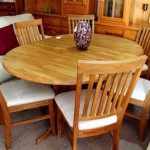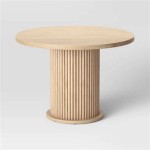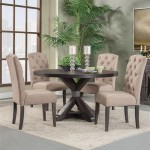Determining the Optimal Size of Rug Under a Dining Room Table
Selecting the appropriate size of a rug to place under a dining room table involves a nuanced understanding of both functional requirements and aesthetic considerations. A poorly sized rug can disrupt the flow of a dining space, create an uncomfortable dining experience, and detract from the overall visual appeal of the room. Conversely, a well-chosen rug can anchor the dining area, enhance the room's acoustics, and contribute significantly to its design cohesion. This article provides a comprehensive guide to determining the optimal rug size for a dining room, focusing on key factors that influence the decision-making process.
Understanding the "Add 24-30 Inches" Rule
The fundamental principle in selecting a dining room rug size centers around ensuring that all chair legs remain on the rug, even when the chairs are pulled out from the table. This prevents the disconcerting experience of chairs wobbling or catching on the rug’s edge and provides a more comfortable and stable seating arrangement. The standard recommendation is to add 24 to 30 inches to the dimensions of the dining table on all sides. This "add 24-30 inches" rule is a helpful guideline, but it should be adjusted based on the specific dimensions of the dining table and the surrounding room.
For example, if the dining table is 48 inches wide and 72 inches long, adding 24 inches on each side would result in a rug size of 96 inches wide (48 + 24 + 24) and 120 inches long (72 + 24 + 24). Similarly, adding 30 inches to each side would yield a rug size of 108 inches wide (48 + 30 + 30) and 132 inches long (72 + 30 + 30). These calculations provide a starting point for determining the ideal rug size, but further adjustments are necessary to account for room size and shape.
The choice between adding 24 inches or 30 inches often depends on the available space in the dining room. If the dining area is relatively confined, adding 24 inches may be more appropriate to prevent the rug from overwhelming the room. Conversely, in a larger dining room, adding 30 inches can create a more visually balanced and spacious feel. Visualizing the rug size using painter's tape can be extremely helpful in this decision-making process. Taping out the potential rug dimensions on the floor allows one to assess how the rug will interact with the surrounding furniture and space.
Accounting for Room Size and Shape
Beyond the dining table dimensions, the overall size and shape of the dining room significantly influence the selection of the appropriate rug size. A rug that is too large for the room can make the space feel cramped and disproportionate, while a rug that is too small can appear insignificant and fail to adequately anchor the dining area. The rug should generally be centered beneath the dining table, with adequate space around the perimeter to avoid a crowded or unbalanced look.
In smaller dining rooms, it is crucial to maintain sufficient visible floor space around the rug to prevent the room from feeling claustrophobic. If the dining area is located within an open-concept space, it may be necessary to consider the flow and integration of the dining area with the adjacent rooms. The rug can serve as a visual marker that defines the dining area within the larger space, but it should not impede movement or create a sense of separation.
For oddly shaped dining rooms, such as those with alcoves or angled walls, it may be necessary to deviate from the standard rectangular rug shape. In such cases, an oval or round rug may be a more suitable option, as these shapes can soften the angles and create a more harmonious visual effect. Alternatively, a custom-shaped rug can be designed to precisely fit the unique dimensions of the room. When considering non-rectangular rugs, the "add 24-30 inches" rule should still be applied to the widest and longest points of the table to ensure that chair legs remain on the rug when pulled out.
Considering Table Shape and Extension Leaves
The shape of the dining table is another crucial factor that influences the selection of the rug size. While rectangular rugs are commonly used under rectangular tables, round or oval tables often benefit from a rug of a similar shape. A round rug can echo the circular form of the table, creating a sense of visual harmony. However, a rectangular rug can also be used under a round table, particularly if the room has a more angular design aesthetic. The key is to ensure that the rug is large enough to accommodate the chairs when they are pulled out, regardless of the table shape.
If the dining table has extension leaves, the potential increase in table size must be taken into account when selecting the rug. The rug should be large enough to accommodate the table in its fully extended configuration, ensuring that chair legs remain on the rug even when the extension leaves are in place. This may require choosing a larger rug than initially anticipated, but it will prevent the need to replace the rug later when the table is extended for larger gatherings.
For instance, a round table that is 48 inches in diameter might extend to an oval shape of 48 inches by 72 inches when the extension leaf is added. In this case, the rug should be sized to accommodate the oval shape, adding 24-30 inches to both the width and length. Ignoring the potential for extension leaves can result in a rug that is adequately sized for everyday use but becomes too small when the table is expanded. Taking the time to measure both the unextended and extended dimensions of the table is essential for making an informed decision about rug size.
Furthermore, the style of the dining table can influence the aesthetic choice of rug. Tables with ornate legs or a highly detailed base may benefit from a rug with a simpler pattern or a solid color to avoid overwhelming the overall design. Conversely, a minimalist dining table can be complemented by a more elaborate or patterned rug, adding visual interest and personality to the space. The rug should work in concert with the table and chairs to create a cohesive and visually appealing dining area.
Navigating Common Sizing Scenarios
Several common dining room scenarios present specific challenges when choosing a rug size. These situations often require a more tailored approach than the general guidelines provide. One such scenario is a dining area located in a corner of a larger room. In this case, the rug should be large enough to define the dining area and visually separate it from the rest of the space. However, it is important to ensure that the rug does not encroach too far into the adjacent room, creating a sense of visual imbalance. Using furniture placement and the rug edge as visual cues can help delineate the dining space effectively.
Another common scenario involves a dining table placed near a wall or doorway. In this situation, it may not be possible to add 24-30 inches of rug space on all sides of the table. The priority should be to ensure that chair legs remain on the rug when the chairs are pulled out on the open sides of the table. On the side adjacent to the wall or doorway, the rug can be closer to the edge of the table, but it should still provide sufficient space for comfortable seating.
For dining areas with bench seating on one or more sides of the table, the rug should extend far enough to accommodate the bench when it is pulled out from the table. This may require a larger rug than would be necessary for chairs, as benches often require more space for comfortable seating. It is also important to consider the height of the bench in relation to the table, as a bench that is too low can create an uncomfortable dining experience. The rug can help visually connect the bench and table, creating a cohesive and inviting seating area.
Ultimately, the optimal rug size for a dining room table is a balance between practical considerations, such as ensuring that chair legs remain on the rug, and aesthetic considerations, such as maintaining visual harmony and proportion within the room. By carefully considering the dimensions of the table, the size and shape of the room, and any unique challenges presented by the space, a well-chosen rug can enhance the comfort, style, and functionality of the dining area.

The Ultimate Guide To Choosing Perfect Size Rug For Your Dining Table Luxury Custom Furniture

Dining Room Rug Guide Pottery Barn Australia

What Size Rug To Use In A Dining Room Green With Decor

Expert Advice How To Design A Perfectly Scaled Dining Room

How To Choose The Right Rug Size

Pin Page

How To Choose The Best Dining Room Rug Size Color Caravan

My Favorite Rugs Under 100

What Size Rug Under Dining Table Here S The Best Way To Find Righ

Your Guide To Outdoor Rug Sizes Authenteak
See Also








